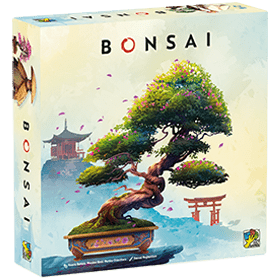bonsai
 The Japanese term "bonsai" means "planted in a pot". A bonsai is a living work of art, a perfect miniature plant, identical in all respects to its full-size simile, but several times smaller.
The Japanese term "bonsai" means "planted in a pot". A bonsai is a living work of art, a perfect miniature plant, identical in all respects to its full-size simile, but several times smaller.
In Bonsai, players take on the role of expert bonsai masters intent on growing their own bonsai. Whoever grows the best plant will be appointed to show their Bonsai at the Imperial gardens.
LB_NUMBER_OF_PLAYERS: 1 - 4
Game duration: 15 mn
Complexity: 2 / 5
Play bonsai and 977 other games online.
No download, directly from your web browser.
With your friends and thousands of players from the whole world.
Free.

Play bonsai and 977 other games online.
No download, directly from your web browser.
With your friends and thousands of players from the whole world.
Free.

Rules summary
Overview
Build your Bonsai with Tiles whilst collecting cards in order to play different and more tiles per turn, meanwhile decide which goals you wish to pursue and which you want to permanently ignore
Turn
On your turn, either Meditate or Cultivate, then check if you've Completed a Goal
Meditate
Take a faceup card of your choice
Below the card's position are symbols depicting how many and what type or tile you can additionally take
Some positions give no tiles, some an option between one and another tile, and some give multiple tiles
All remaining cards are slid to the right, and a new card is drawn from the deck to refill the market
• Growth cards are played to the right of your Seishi, fanned out to keep the symbol on the sidebar visible
• Tool cards are played to the left of your Seishi, fanned out to keep the symbol on the sidebar visible
• Helpers and Masters have instant one off effects, then are placed facedown next to you in a pile
• Parchments have end game effects, and are placed facedown in the same pile as Helpers and Masters
Regardless of how many tiles you gained, you can only retain 5 tiles at the end of your turn
Cultivate
Based on what cards are in your display, including your starting Seishi card, you are allowed to play certain tiles as depicted
Each depicted tile lets you place one of its type, the starting Seishi allows a player to place 1 Wood, 1 Leaf, &/or 1 Any
• Wood needs to be placed with one edge touching the edge of another Wood
• Leaf needs to be placed with one edge touching the edge of a Wood
• Flower needs to be placed with one edge touching the edge of a Leaf
• Fruit needs to be placed adjacent to two Leaf tiles which form an intersection, furthermore a Fruit CANNOT touch the edge of another Fruit
Before placement, if your layout does not allow for a Wood placement (regardless of what you wish to place) you can discard parts of your Bonsai in the least disruptive manner in order to make Wood placement possible
Complete a Goal
If you meet or exceed the requirements of a goal, you are able to claim it or skip it
You can only claim one goal of each type, so once one is claimed you cannot claim a better version
If you choose to skip a goal you could have claimed, it is no longer available for you to claim at a later point, you must instead try to claim a harder goal worth more points
Game End
When the deck is depleted and the final card revealed, all players including the player who caused this get 1 final turn
Hand Tiles are worth nothing, tiles in the Bonsai are scored as follows
• Wood is worth 0
• Leaf is worth 3 each
• Flowers are worth 1 for each side NOT adjacent to another tile (so worth 0 - 5 each)
• Fruit is worth 7 each
• Reveal your Parchments and score them as detailed, then add to this any Goal cards collected
The player with the most points, wins!
If tied, the player furthest from the start player, wins!
Settings
The tokonoma variant puts all of the Parchment cards in the top half of the deck.


